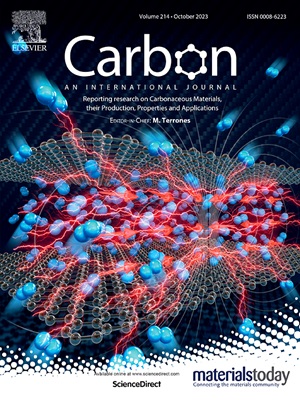Synthesis of PAN/ZIF-67 derived composite fibers through electrospinning technology with superior Ku-band electromagnetic absorption performance
IF 10.5
2区 材料科学
Q1 CHEMISTRY, PHYSICAL
引用次数: 0
Abstract
With the rapid development of 5G technology, electromagnetic pollution has emerged as a critical concern. Composite nanofibers prepared by electrospinning technology have the advantages of low density, high flexibility and easy processing, and are important materials for electromagnetic wave (EMW) absorption. In this work, cubic zeolitic imidazolate framework-67 (ZIF-67) was uniformly incorporated into carbon nanofibers (CNFs) through electrospinning, and then carbon nanofibers/cobalt (II) oxide/cobalt/nitrogen-doped carbon (CNFs/CoO/Co/NC) composite fibers were prepared by calcination at different temperatures. The magnetic carbon composites derived from cubic ZIF-67 were integrated with CNFs to form bamboo-like composite fibers. The unique microstructure and reasonable selection of calcination temperature provided channels for energy and charge transfer, increasing the multiple scattering of waves within the composite fibers. When the calcination temperature was 800 °C, the CNFs/CoO/Co/NC composite fibers exhibited the minimum reflection loss of −63.71 dB at a matching thickness of 2.56 mm and the broadest effective absorption bandwidth of 7.92 GHz at 3.2 mm and a low filling ratio of 10 wt%. Furthermore, the obtained composite fiber presented the best radar cross section (RCS) reduction performance, reaching the maximum value of −52.37 dB m2. Additionally, the potential EMW dissipation mechanism was also revealed. Therefore, this work provided a new strategy for producing CNFs-based composites through electrospinning as broadband and highly efficient EMW absorbers.
利用静电纺丝技术合成具有优异ku波段电磁吸收性能的PAN/ZIF-67衍生复合纤维
随着5G技术的快速发展,电磁污染已经成为一个严重的问题。采用静电纺丝技术制备的复合纳米纤维具有密度低、柔韧性高、易加工等优点,是吸收电磁波的重要材料。通过静电纺丝将立方沸石咪唑酸框架-67 (ZIF-67)均匀掺入纳米碳纤维(CNFs)中,在不同温度下煅烧制备纳米碳纤维/氧化钴/钴/氮掺杂碳(CNFs/CoO/Co/NC)复合纤维。以立方ZIF-67为基材制备磁性碳复合材料,并与CNFs结合形成竹状复合纤维。独特的微观结构和煅烧温度的合理选择为能量和电荷的传递提供了通道,增加了复合纤维内部波的多次散射。当煅烧温度为800℃时,CNFs/CoO/Co/NC复合纤维在匹配厚度为2.56 mm时的反射损耗最小为- 63.71 dB,在匹配厚度为3.2 mm时的有效吸收带宽最宽为7.92 GHz,填充率低至10 wt%。此外,所制备的复合光纤具有最佳的雷达截面(RCS)降低性能,达到了- 52.37 dB m2的最大值。此外,还揭示了潜在的EMW耗散机制。因此,本研究为通过静电纺丝制备cnfs基复合材料作为宽带高效EMW吸收剂提供了一种新的策略。
本文章由计算机程序翻译,如有差异,请以英文原文为准。
求助全文
约1分钟内获得全文
求助全文
来源期刊

Carbon
工程技术-材料科学:综合
CiteScore
20.80
自引率
7.30%
发文量
0
审稿时长
23 days
期刊介绍:
The journal Carbon is an international multidisciplinary forum for communicating scientific advances in the field of carbon materials. It reports new findings related to the formation, structure, properties, behaviors, and technological applications of carbons. Carbons are a broad class of ordered or disordered solid phases composed primarily of elemental carbon, including but not limited to carbon black, carbon fibers and filaments, carbon nanotubes, diamond and diamond-like carbon, fullerenes, glassy carbon, graphite, graphene, graphene-oxide, porous carbons, pyrolytic carbon, and other sp2 and non-sp2 hybridized carbon systems. Carbon is the companion title to the open access journal Carbon Trends. Relevant application areas for carbon materials include biology and medicine, catalysis, electronic, optoelectronic, spintronic, high-frequency, and photonic devices, energy storage and conversion systems, environmental applications and water treatment, smart materials and systems, and structural and thermal applications.
 求助内容:
求助内容: 应助结果提醒方式:
应助结果提醒方式:


